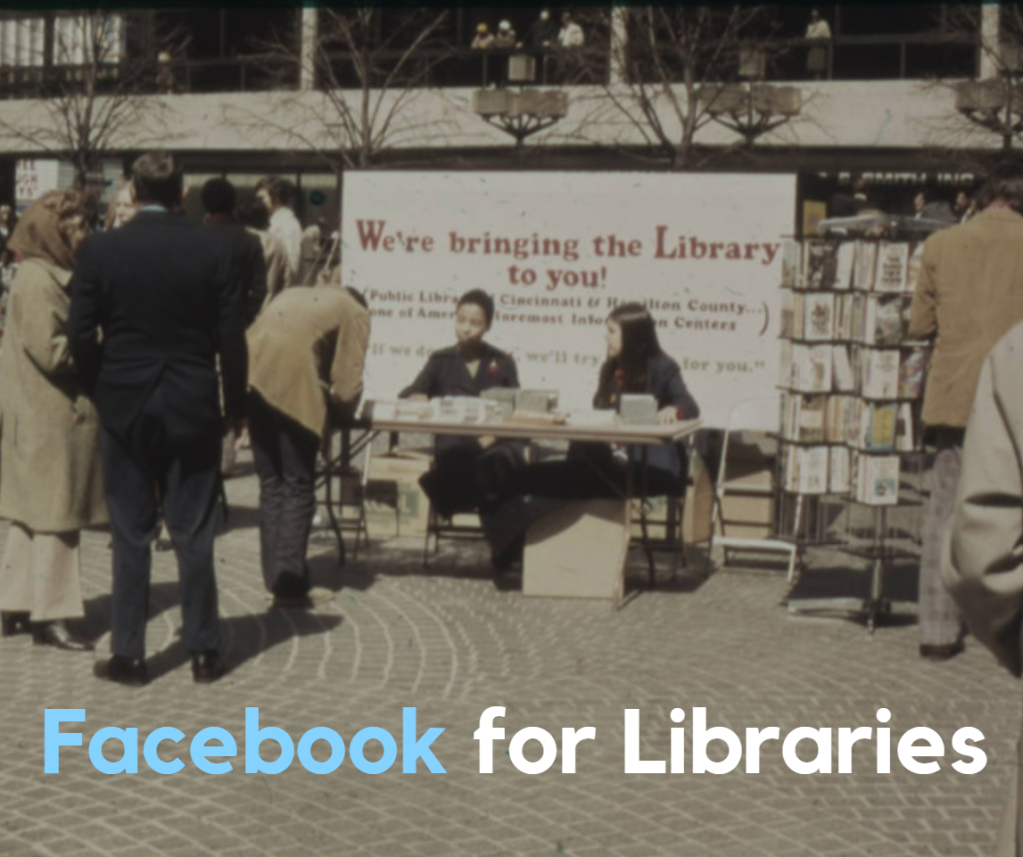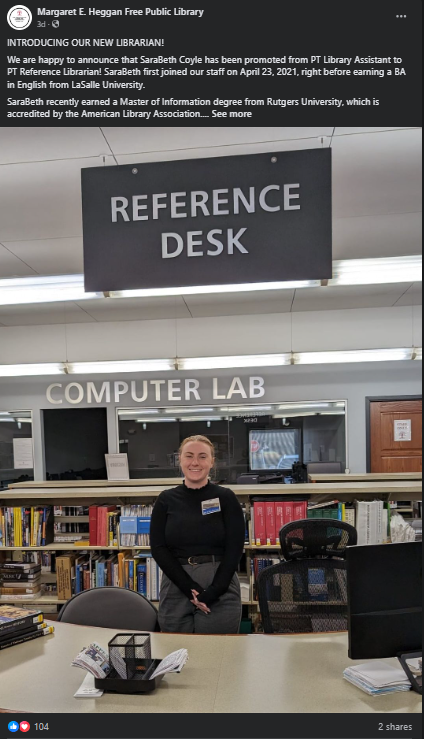
This is part of the 2024 series of social media guides for libraries. It includes posts on:
We’ll cover Twitter/X on Dec. 18. Stay tuned!
Facebook for libraries
Once again, Facebook remains the single most popular social media platform for libraries. In fact, the percentage of library staff who use Facebook for library marketing rose by 7 percentage points this year, to a whopping 97 percent, according to the annual Super Library Marketing Survey.
I believe part of that rise can be traced to the turmoil at X, formerly known as Twitter. I’ve talked with libraries who shifted their focus back to Facebook this year because they could no longer rely on Twitter/X for reach.
And overall Facebook organic engagement rose this year for the first time in a while. It appears that Meta took advantage of the chaos at Twitter/X by adjusting their algorithm to boost organic reach, and that’s good news for all of us.
According to Statista, Facebook is the largest social media platform in the world, with 2.9 billion monthly active users. 70 percent of Americans log on each day, and 74 percent of Canadians log on daily. Canada, by the way, has the highest daily log-on percentage for Facebook in the world!
How are people using Facebook right now?
Here are some statistics to consider from SocialPilot.
- Facebook users spend an average of 19.42 hours a month on the platform.
- Most Facebook users (nearly 82 percent) use the mobile version of the platform. But that percentage has dropped from last year. Interesting, right?
- 31 percent of Americans use Facebook to get their news. 🙁
- And here’s the whopper stat: Facebook use among teens in the US has dropped significantly this year, by 39 percentage points, to just 32 percent. So… don’t use Facebook to try to reach teens.
- However, people between the ages of 25 and 34 make up the largest audience on Facebook. That one took me by surprise!
How much success can we see on Facebook?
These engagement statistics come from Hubspot and SocialPilot.
- The median engagement rate for Facebook is 0.060 percent. Ouch.
- Facebook photo posts get the highest engagement rate, at 0.12 percent.
- The average Facebook user likes 11 posts every month.
- Live videos on Facebook get 26 percent higher engagement than live videos on other platforms.
- Almost 50 percent of the time people spend on Facebook is spent watching videos.

The Facebook algorithm for 2024
Here are the ranking signals Facebook uses to decide who sees your posts.
- Facebook prioritizes content from friends and family members over content from business pages. For libraries, this means that it’s important to get people to comment or share your posts. When they do that, the friends and family members of your engaged users are more likely to see your content. And those engaged followers will see more of your library’s content.
- Facebook prioritizes posts based on both the number and length of comments.
- Facebook prioritizes posts that have a higher number of reactions and a variety of reactions.
- Facebook prioritizes the type of content that people like. So for example, if your Facebook videos are the most popular type of content posted from your library’s page, Facebook will show people more of your videos and less of your other types of content like photo posts or plain text posts.
Here are four ways to get the best organic reach for your library’s Facebook posts in 2024.
Create a formula that emphasizes entertaining posts and encourages meaningful interaction.
People are coming to social media to connect with friends and for entertainment, according to data released by Oberlo earlier this year.
I heard this at the Library Marketing and Communications Conference too. Facebook users are increasingly using the platform to fill time and fight boredom. (That’s why video is such a big deal on Facebook–it’s fun to watch!)
To keep our Facebook audience engaged with our posts, we need to make them entertaining. Experiment to create a formula to balance posts that build your library’s brand and raise awareness of your library offerings. That might look like this:
- Entertaining posts including memes, GIFs, fun library-centric videos, and conversation starters: 70 percent
- Sharing other people’s content, including library users and partners: 20 percent
- Promotional posts: 10 percent
Create a formula based on your audience and your library’s overall goals. Then experiment with it for a month. Check your insights. If your audience engagement is steady, or growing, you know you’ve hit on the right combination! If you haven’t seen any growth in engagement, you can try adjusting your formula.
Each library’s audience is unique, so your formula will be different than the formula used by the library in the neighboring town.
Share links in the comments, not in the post.
The reach of link posts continues to decline. According to Social Media Today, views of Facebook posts that include links have declined by as much as 50 percent in the past two years. This is because Meta is turning away from news and informative content. Now it’s more focused on entertainment.
Click on the post below to see how Champaign Public Library uses this technique.
If you are trying to drive awareness of an event or promote an item in your collection, share the link to your event calendar or catalog in the first comment after you publish the post. For those of you who use scheduling apps to manage your posts, that means you will have to go to Facebook after the post schedules and add the link. Yes, I know it’s a pain.
The alternative option is to use visual elements or video to explain the action you wish the public to take, rather than adding the link to the comments. In other words, create a graphic carousel with words that convey the action you wish your followers to take. Just be sure to add alt text to your images so viewers with visual impairments can also interact with your posts.
Try simple text-only posts in the feed.
Katie Bulloff of the Indianapolis Public Library uses this method to great results. She usually asks a question or posts a prompt to get the conversation going.
Just be careful with the backgrounds and text provided by Facebook. They’re not always accessible. Use a color contrast checker to make sure you’re in compliance with accessibility standards.
Clermont County Public Library also uses this technique.
Post videos to Facebook, including Reels and Stories.
The ability to cross-post your Instagram Reels to Facebook makes it a no-brainer to use this feature. Meta is highly focused on video content and continues to add more features including A/B testing, creating Reels from existing clips, and more.
And it doesn’t have to be complicated. Here is a Reel that Plainville Public Library created from a series of static photos. As of this writing, it’s gotten more than 300 views. Their service population is less than 17,000 residents!
Facebook (and other platforms) are focused on video because that’s the kind of content that increasingly gets attention from followers. It’s entertaining. So, here’s the plan.
- Post to Reels.
- Share your Reel to your Stories.
- Share your regular Facebook Feed posts to Stories.
- Post original content directly to Stories.
Stories are extremely popular with users. My Gen Z daughters never look at the Feed. They only look at Stories. So it makes sense to devote library marketing energy to that feature.
Maybe also try…
Facebook Groups: I’ve heard libraries talk about the varying degrees of success using the Groups feature. I really think it depends on your specific community. But certainly, if you haven’t experimented with Groups, now might be a good time to do that!
Groups are not for promotion: rather, they’re a community-building tool. However, if you can build an engaged Facebook Group, it goes to reason that the members of that group will see more of your regular Feed, Story, and Reel posts!
Messaging your followers: Social Media Today says many Facebook pages are switching to private messaging groups to share their latest updates, as opposed to posting publicly. Your messages would be outside the influence of the algorithm. It’s worth experimenting with!
When to post on Facebook
- Post once a day on the Facebook feed, either early in the morning, around lunchtime, or around 8 p.m.
- Post at least one slide to Facebook Stories every day.
- Post a Facebook Reel once a week.
P.S. Want more help?
It’s Okay To Take A Break From Social Media! Here Are the Benefits of a Pause for Your Library
Subscribe to this blog and you’ll receive an email whenever I post. To do that, enter your email address and click on the “Follow” button in the lower left-hand corner of the page. You can also follow me on the following social media platforms:
November 14, 2023 at 6:56 pm
Loved this post – heress my feedback –
Thanks for reading , Love The Blog !!
Thanks – TheDogGod – Pomeranian Puppies & Adult Dog Guides & Tips pomeranianpuppies.uk
LikeLike
January 2, 2024 at 10:42 am
Thanks for the tips- I will try a few new strategies. I agree that teens aren’t looking at the library Facebook page, but their parents are, so I still post information about programming for the parents to see. Plus, our community loves seeing pictures of the teens at the library, so those also go up on the page.
LikeLike